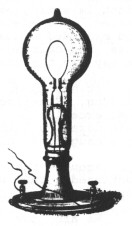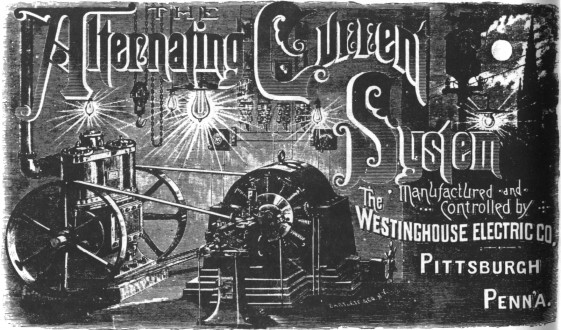Advantages & Drawbacks Of Electric Light For The Year 1882
(Condensed and Edited by Elton Gish)
Reprinted from "Crown Jewels of the Wire", August 1989, page 21
With the invention of the incandescent lamp by Edison (patented Jan. 27,
1880) not much more than a novelty in 1882, electric lighting was limited to
carbon arc lamps and the Jablochkoff candle, a modern and more efficient version
of the carbon arc lamp. Most lighting was from the use of gas or oil lamps.
There were no power plants anywhere in the world, just simply gas-motors and
steam-engines-driving generators to supply electricity for local or private
consumption.
The benefits of electric lighting were still being debated, a debate that
would quickly be settled with the successful commercial operation of Edison's
Pearl Street Station power plant in New York City on September 4, 1882. Edison's
power plant and distribution network supplied direct current at 110 volts to 59
customers lighting a total of 1284 of his new incandescent lamps. The first high
voltage transmission line in the U. S. was installed nine years later, in 1891,
at Telluride, Colorado where it operated at 10,000 volts. By then, the
disadvantages of electric light were totally gone.

However, when the book, The Modern Applications of Electricity by E.
Hospitalier (translated from French by Julius Maier) was published in 1882, the
debate on the advantages and drawbacks of electric light was firmly rooted in
the past with hope for the future. Acceptance of new ideas, as even today, were
resisted until Edison's economical lamp was demonstrated.
The Electrical Exhibition held at Paris in 1881 astonished the world. It
brought home to everyone the irresistible conviction that electrical appliances
are destined to play a most important part in the future, and that we shall,
before long, be dependent upon these appliances, not only for our comforts, but
even for the necessities of daily life. The following discussion taken from this
book, may enlighten your appreciation of life in the 19th century -- merely 107
years ago.
-------------------------------------------------------
Applications where electric light has rendered good services, and services
which gas-light could never have performed, are numerous and varied. We find it
used in railway stations, workshops, public squares, churches, theaters,
libraries and skating rinks.
We must not forget the fanciful applications which certain very enthusiastic
inventors keep in store for the electric light. Some of them proposed to light a
whole town by setting up, in some elevated spot, a light of unsurpassed splendor
-- a sort of electric sun. A study of the law of the square of distances will
soon destroy this illusion. Others have proposed to light carriages with
electricity, by utilizing the motion of the vehicle itself, and for several days
an advertising carriage, founded on this idea, was driven about Paris. But --
and this is a terrible "but" -- when the carriage stops, the light is
extinguished, just at the moment when it is most wanted. The electricity might,
of course, be stored up and expended during the time of stoppage, but, in that
case, the carriage would be considerably overcharged, and we may say the game is
not worth the candle.
It has been proposed to employ electric light for fishing. Experiments made
have proved that the method was excellent -- to drive away the fish frightened
by this dazzling light. It was certainly not the fish that were caught by this
experiment.
Amongst the more serious applications must be mentioned the use for projections in teaching,
reproductions of photographs and photography at night.
We are now going to examine the advantages and drawbacks of electric light,
and what a great future there is in store for it, provided this progress, as we
have every reason to expect, continues at the same rate it has followed for the
last few years.
It is incontestable that when a light of great intensity is required, for
instance, in a fort for watching the enemy, in ports for preventing the
destructive effects of torpedo-boats, in lighthouses for guiding the navigators,
electric light is not only the most economical of all, but often the only
practical one. It is equally certain that for a vast enclosure like that of the
Hippodrome [an arena for equestrian shows] in Paris, where it is impossible to
suspend lighting apparatus and to place candelabra in the ring, the electric
light is the only possible one, the only one which can replace the absent sun.
We may, therefore affirm, that electric lighting has its own domain, where it
need fear no opposition from any other system.
Another advantage of the electric light is the feeble quantity of heat
produced. This is a very valuable property, which is very much appreciated where
the heat produced by gas is really unbearable.
Another advantage of the electric light -- an advantage which is, however,
contested by a great many impartial persons -- is its tint, which permits the
distinction of the most delicate shades of colors. Contrast alone imparts to it
that pallid tint which is considered objectionable, and we have only to look at
the sane time at a gas flame and a Jablochkoff candle to see how little
foundation there is for this objection. It is altogether the fault of the gas,
which has a decidedly yellow tint; but our eyes are so accustomed to this
colored light, that electric light, which, like sunlight, contains all the
colors of the spectrum, seem to us inferior, because it is on the contrary too
rich, and objected to from the very excellency of its qualities.
Further advantages are that electric light has no smell, renders explosions
impossible, diminishes the chances of conflagrations [large fires], enables us
to obtain a light at long distances from the place of production -- an advantage
which gas possess at least to the same extent -- and finally, if no direct but
reflected light is required, it yields a splendid diffused light which can, from
an economical point of view, successfully compete with gaslight.
And now let us consider the drawbacks. The first drawback, which is of a
transitory nature, and is gradually disappearing as the [generation] apparatus
are improved, arises from a want of constancy (stable voltage and service) of
the light, either with regard to its intensity or its color. With apparatus
available today, great constancy can be obtained, provided they are well
constructed and regulated. The inconvenience arising from extinctions [loss of
power] of short duration owing to accidental causes, disappears more and more,
in proportion as the staff entrusted with the manipulations becomes more
experienced.
Certain electric lamps make a very tiresome noise, which excludes them from
localities where silence is desirable. This particular noise may be very slight
in [electric] candles and regulators which employ alternating currents, but it
cannot be altogether avoided: it arises from the very nature of these
[alternating] currents, and can only be completely obliterated by the use of
continuous [direct] currents: these currents find altogether more frequent
applications for electric appliances than alternating current.
The most serious drawback is that the hydro-electric power plant is not
practical or economical and the thermo-electric [gas or coal fired] power plant
is still in the state of an experiment, so that only gas engines alone are
available for producing current.
While waiting for its complete solution, the advantages of electric light are
so conspicuous that they altogether outweigh even this serious inconvenience.
steam-engines, gas-motors and hydraulic-motors are now specially and exclusively
employed for electric lighting; their number increases every day, which is the
best proof we can adduce for this system of lighting. With the results already
obtained, it is hoped that within a very short time electric lighting will have
become one of the necessities of domestic life. The past here promises well for
the future.
-------------------------------------------------------------------------------
The following advertisement appeared in the "Electrical Review" dated
May 5, 1888. It is typical of the state of the art for electrical power
generation before the popularity of centralized power plants began in the early
1890's, and, with it, the development of insulators for voltages greater than
that required for telegraph service.

|
